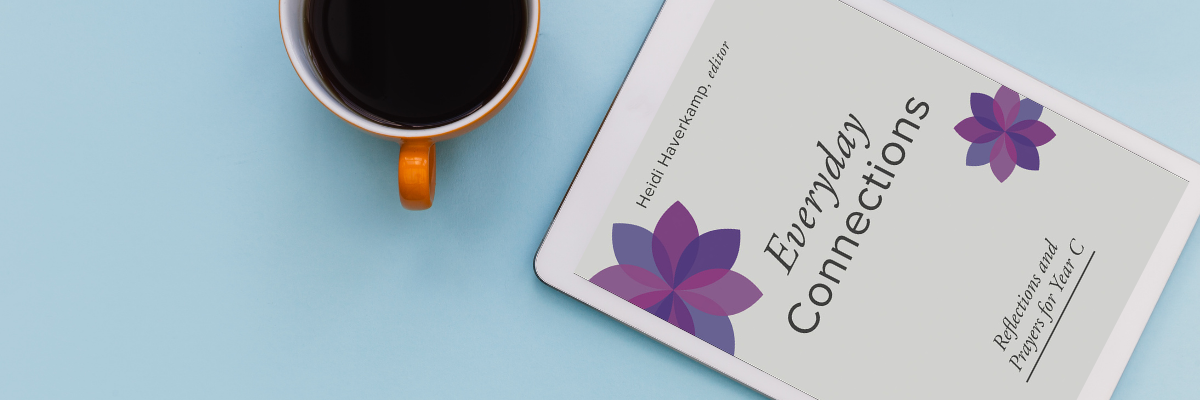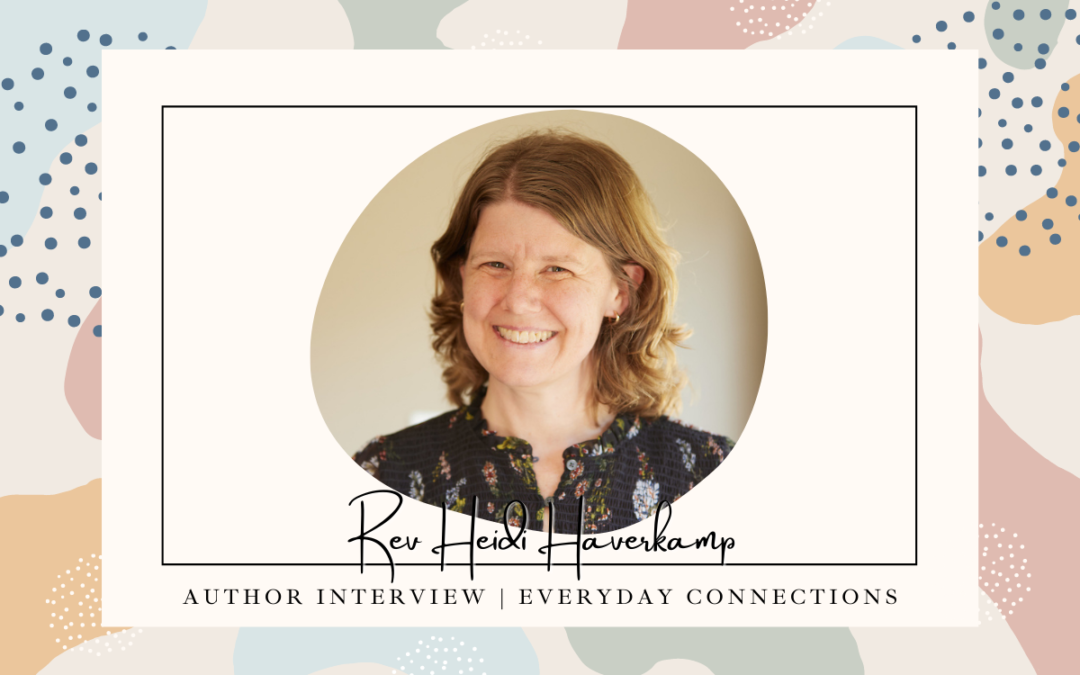I had long appreciated Rev. Heidi Haverkamp’s writing at the Christian Century but fell in love with her perspective on faith when she launched her newsletter Part Time Hermit. There was something about her reflections that appealed to my bookish, pastoral sensibilities—the wrestling with the idea and practice of being cloisters away (sort of) from the noise of modern life (sometimes). When I saw that Heidi was set to release Everyday Connections: Reflections and Practices for Year C, I knew it was a resource that would enrich my spiritual life and Heidi would be an author that readers would benefit from getting to know a bit better.
CG: The longer I am on my journey and particularly in these late stages of the pandemic, I appreciate a sense of steadiness in my spiritual life. Those daily habits that stretch months or seasons ground me in a different way. I love that your newest book offers a full year of daily devotions. Tell me what drew you to a project that spans 365 days?
HH: Thanks, Cara! Like you, my daily practices bring so much to my life, although I will be honest and say that I am not always able to do them every single day. Still, starting my day with something meaningful for my life and the world is important to me. So, when my publisher asked me to consider creating this resource, which is based on a sermon commentary series called Connections, first I knew I wanted to craft a book I would also want to use. I wanted to create something to help readers engage with their daily life and the world in a way that is open-ended and flexible, but also serious and weighty, with ideas, prayers, and questions worth their time and attention, not just rhetorical or filler. I also wanted to create something that readers wouldn’t feel they must use every day, 365 days a year. The book is organized around weeks not days. So, a reader can turn to a certain week and choose what they are most drawn to read or practice, or what they have time for, week by week and season by season.
CG: When I read Everyday Connections, the first thing that came to mind about the way you’ve structured the devotional around the four Revised Common Lectionary texts is that it walks the balance between contemplation and action beautifully. Each day there is an invitation to reflection, there are spaces to write and there are questions to explore. Is that a balance you were aware of as you created the structure and wrote the book?
HH: Very much so. Mostly, I wanted to include a lot of options for folks. We’re all different in what speaks to us or works for us as spiritual entry points — even on a week-to-week basis sometimes! Also, we’re used to having options and variety (thanks, internet!) so, rather than fight against our varying attention spans, I wanted to create a resource that offered many doorways into the readings. One week, someone might have the time and desire to read all the scriptures and think about them all together. Another week, maybe they only have time for one scripture that really is speaking to their life. Or a reader doesn’t have much time and just needs to write a sermon one week, so scans all the entries to find a question or insight that gets their juices going. Or a reader feels bored, and goes looking for a question, quote, or a spiritual practice that turns things upside down, somehow, spiritually for them that week.

CG: As you wrote the book and as you sit with it now, what spiritual practice for reflecting on scripture resonated with you? In other words, what is giving you joy in your own scripture reading and reflection?
HH: A practice that has become quite meaningful to me is writing out a passage of scripture in longhand. I was introduced to this because of an article I wrote a couple of years ago, covering some churches that were trying to handwrite the whole Bible as a pandemic group project, illuminating passages with drawings and personal notes, too. Writing a passage out in my own handwriting opens up a whole new dimension in encountering the words, I find, different than just reading or hearing. Sometimes I do this in my journal but mostly I use scratch paper, so I feel free to just scribble and interact with the words as they meet me that day. Maybe I’ll rewrite one phrase or word over and over, or rephrase the words in my own voice, or make some drawings in the margins. I offer this as a spiritual practice in Everyday Connections, but more in the upcoming volume Year A (coming in Fall 2022) than in Year C, since Year C was mostly written by the time I wrote that article. I’m working on Year B, now – the last of the three, which will be out in Fall 2023.
CG: A lot of the work I am doing right now centers around helping congregations think through how to regather their communities on this side of the pandemic. Small gatherings seem to make the most sense for both safety and social reasons and so I was delighted to see that Everyday Connections includes a small group guide. Individual spiritual reflection is somewhat different than a small group spiritual reflection, so I am curious what the thought process was behind creating a resource that could be used both ways?
HH: When I wrote my last book, Holy Solitude, I thought I was writing a book only individuals would use. I mean, it’s about solitude! But I was surprised how many requests I got from readers and pastors, asking for help creating a format to use with a small group. Many folks, it seems to me, are finding community and spiritual growth in small groups these days and looking for books and resources to help them go deep, both in study and in their questions about their personal life, call, and spiritual longings. I have loved being part of groups like this in my own life and churches, and wanted to encourage people. Especially to be in conversation with something that can feel as stodgy as the Revised Common Lectionary! Another fun thing about Everyday Connections is that different folks in the group can choose different reflections or activities, but still talk about the same readings and themes. Whether you prefer to study as an individual or in a small group, you deserve to have something significant, deep, and dynamic as a resource. That was my goal in crafting this series the way I did.
CG: Yes! It seems people are looking to find a balance between solitude and connection. You have a newsletter about hermit life that I absolutely look forward to getting in my inbox. What draws you to the hermit life and what does that have to do with cultivating a spiritual life?
HH: I’ve dreamed of being some kind of hermit since I was a kid. I’ve always loved being on my own — reading, wondering, writing, walking, or just cleaning the house or making dinner. One of the great gifts of my life is enjoying spending time with God in this way. But for years, I didn’t prioritize it. I felt I couldn’t – it seemed selfish and useless. It was never on my to-do lists and never written in my calendar. But I have come to feel that solitude is not just a hobby but part of my vocation as a person and as a priest because it helps me write, it helps me listen better to others as a spiritual director, it helps me love my neighbor more fully, and it just helps me be myself, as God created me. I mean, I also love people, and my husband, my family, and my friends – so I like to joke that I’m a “part-time hermit.” Being in community enriches my solitude – I don’t want to be the kind of hermit to go off into the woods and never be around human beings again.
If there are readers out there who love solitude but feel it’s a waste of time or selfish to take time alone, I pray they will reconsider. Even short pauses of solitude or a couple hours now and then can be a great gift for your spiritual life and your life with God. It almost doesn’t matter how you spend it – reading, walking, people-watching, yard work. But social media, the internet, or streaming don’t leave much room in your head to listen for your own thoughts or to notice the world and the Spirit around you, which I think are the best spiritual gifts of spending some time alone.
CG: I often think about Mary Oliver and the way she sought solitude in the forest and yet her work connects so many. Our solitude breeds a sort of unexpected wonder and connection.
Is there something even the most extroverted and social of us can learn from hermit practices?
HH: Some people come to me for spiritual direction or find me online and tell me something like, “I know I really should spend more time in solitude!” Maybe. But solitude isn’t like exercise or protein: something all humans have to do or ingest to be healthy. God made us all different, with different ways of being spiritually whole and feeling God’s love. I hope folks will follow their own longings, whether it’s for solitude or something else.
Still, maybe extroverts can benefit from two lessons of “hermit values.” First, to become aware of the temptation in Western and capitalist life to ceaseless busyness, noise, and usefulness. This is not how humans were created to function. We need creative time, quiet time, social time, and time to be aimless, because our brains and our bodies need time to rest and reflect. Second, if there is something in your life that brings you spiritual deepening or joy but seems silly, selfish, or wasteful (which is how solitude felt to me for much of my adult life), I hope you will reconsider and find ways to let your heart have what it longs for! God put these desires on our hearts for a reason, I think – perhaps having to do with feeling joy at being alive or delighting in being ourselves.
CG: Sometimes we take our spiritual lives so seriously we forget that God delights in us and that cultivating delight is holy. Where can people find you if they want to connect or follow your writing?
People can find me on my website and if they are interested in reflections on the hermit life, they can sign up for my newsletter Part Time Hermit. I am also on Instagram and Facebook.



Recent Comments